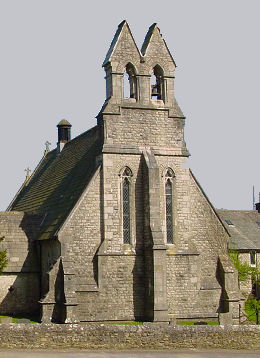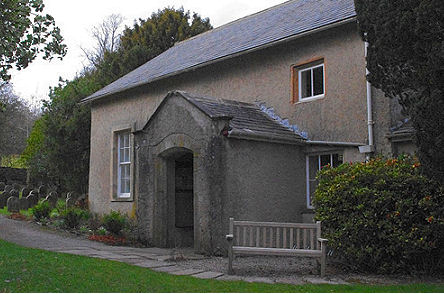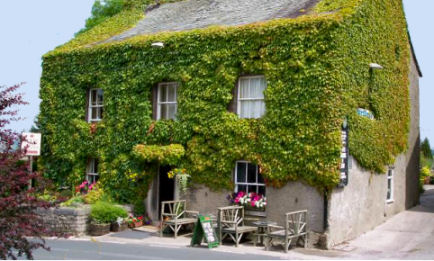Yealand Conyers
OS Grid ref:- SD5074
 The highly attractive village of Yealand Conyers lies to the north of Lancaster, and close to the border of Cumbria.
The highly attractive village of Yealand Conyers lies to the north of Lancaster, and close to the border of Cumbria.
The village is situated in a designated Area of Outstanding Natural Beauty. Yealand Conyers is a limestone area, well wooded and rich in wildlife. The RSPB bird reserve of Leighton Moss is within easy walking distance of the village.
Yealand derives from the ancient Celtic word for 'the land by the ea', the latter word means the stream. The additive Conyers refers to the family who were the lords of the manor in medieval times. In Saxon times Yealand Conyers was held by Tostig, Earl of Northumbria, the brother of King Harold II, in the Domesday Book of 1086 it is recorded as being the property of the Norman Roger of Poitou.
 The village features three churches the Anglican Church of St. John, which was originally a chapelry of the Parish church of St Oswald and the Roman Catholic Church of St. Mary (pictured right) which was built in 1852 built in 1852 for Richard Gillow of nearby Leighton Hall, and designed by the Lancaster architect E. G. Paley, although a church has occupied the site since 1782. The nave boasts a scissor-braced roof, and the roof of the chancel is arch-braced. The reredos is elaborately carved. The altar is supported by marble columns, and the altar rail is in alabaster with green marble columns. The church contains a familt pew for the Gillows at the northwest end, and elsewhere are box pews carved with poppyheads. Also in the church are brasses in memory of members of the Gillow family
The village features three churches the Anglican Church of St. John, which was originally a chapelry of the Parish church of St Oswald and the Roman Catholic Church of St. Mary (pictured right) which was built in 1852 built in 1852 for Richard Gillow of nearby Leighton Hall, and designed by the Lancaster architect E. G. Paley, although a church has occupied the site since 1782. The nave boasts a scissor-braced roof, and the roof of the chancel is arch-braced. The reredos is elaborately carved. The altar is supported by marble columns, and the altar rail is in alabaster with green marble columns. The church contains a familt pew for the Gillows at the northwest end, and elsewhere are box pews carved with poppyheads. Also in the church are brasses in memory of members of the Gillow family
Yealand Conyer's Quaker Meeting House ( left) was built in 1692 following the Toleration Act of 1689. The village is particularly of note for its early support of Quakerism. Richard Hubberthorne, a yeoman farmer and one of the early Quaker preachers was from the Yealands. He probably met Fox in 1652 at Preston Patrick, near Kendal. He built up a strong meeting in Yealand and travelled widely. Like many Quakers, he was imprisoned several times. Eventually he was sent to Newgate gaol in 1662, and died there shortly afterwards.eorge Fox preached a sermon in the village in 1652 and The Quaker's Old School is today used as a simple hostel and can host people visiting '1652 country'.
 The creeper clad village pub The New Inn, (pictured right) dates back to around 1680 and features oak beams and an inviting open log fire. Built to replace the original village ale house destroyed by Oliver Cromwell in the 1600's, the fireplace incorporates part of an old stone mullioned window from the original building. The pub provides fine ales and food which is all homemade from fresh local produce.
The creeper clad village pub The New Inn, (pictured right) dates back to around 1680 and features oak beams and an inviting open log fire. Built to replace the original village ale house destroyed by Oliver Cromwell in the 1600's, the fireplace incorporates part of an old stone mullioned window from the original building. The pub provides fine ales and food which is all homemade from fresh local produce.
Local walks in the area afford impressive views of Morecambe Bay, the Lakeland Fells and the Pennines. Within a few miles are castles, Pele Towers and stately Homes. Nearby Leighton Hall dates back to 1246. This has been a Catholic stronghold and during the period of Catholic persecution, a priest was frequently hidden within the walls. The earliest recorded mention of Leighton Hall dates back 750 years to 1246, when it is known that Adam D'Avranches had a fortified manor there.
On nearby Summerhouse Hill (OS grid ref- SD500743) stands the largest stone circle in Lancashire. The irregular circle has a diameter of 140 metres, and was surrounded by a shallow ditch on all sides with the exception of the east; the surviving portion of the ditch on the north-west is approx 3 metres wide by 0.4 metres deep. There are but four remaining stones in the circle, one of which is split.
Nearby Places of Interest
Leighton Hall- home of the famous furniture making Gillow dynasty and is situated to the west of Yealand Conyers
Carnforth-popular base for walkers and cyclists exploring the area.
Silverdale situated on beautiful Morecambe Bay and forms part of the Arnside and Silverdale Area of Outstanding Natural Beauty, which boasts a rich diversity of habitats and wildlife.
Warton Crag -rising to 163 metres (535 feet) the crag is the highest point in the Arnside and Silverdale Area of Outstanding Natural Beauty (AONB).
Ingleton Waterfalls Trail offers some of the most spectacular waterfall and woodland scenery in the North of England. The trail is 4.5 miles in length and leads through ancient oak woodland and magnificent scenery via a series of stunning waterfalls and geological features.
Lancaster Castle founded in the tenth century
Ashton Memorial in Williamson Park, Lancaster was commissioned by James Williamson, Baron Ashton as a tribute to his second wife, Jenny and was built between 1907 and 1909.
